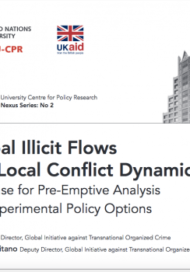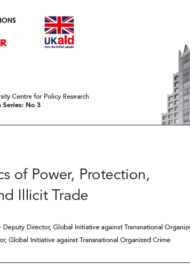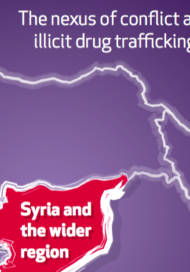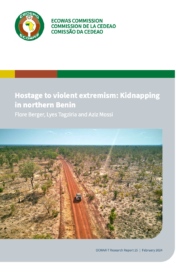Posted on 16 May 2017
This post is a summary of a thematic report published as part of UNU-CPR’s Crime-Conflict Nexus Series.
The role of illicit resources has bedevilled the resolution of conflicts for generations: from the Congo wars, where weapons were supplied in exchange for access to resources like diamonds and gold; to conflicts like Afghanistan and Colombia, where the narcotics economy empowered violent actors and warlords, and consistently undermined efforts towards peaceful resolution and state consolidation. In the contemporary protracted conflicts across the Middle East, North Africa and the Sahel, state fragility, corrosive violence, rising Islamic insurgencies and booming criminal economies seem inextricably intertwined. We seem to have learned few, if any, lessons from the past, and the international community appears challenged to generate new policies or approaches, despite the increasing urgency with which they are sought.
This thematic paper seeks to inject – and to exhort the international community to absorb – a new framework for thinking about the nexus of global illicit flows and local conflict dynamics. It proposes seven shifts that will be needed in the way that conflicts are analysed, monitored and how the findings need to be built into the response.
- Shift the focus from flows to transactions that influence conflict actors
The analysis of organised crime is disproportionately focused on the direction and size of transnational illicit flows – how much is moving; how much it is worth, etc. This is unhelpful firstly because these estimates are often incorrect or distorted, and secondly, because this perspective does not account for the intersection between global flows and local control. The two case studies of Nigeria and Libya both demonstrated that it was often lower value flows that had the greatest importance for local conflict actors.
- Move from illicit ‘snapshots’ to historical trajectories
What analysis that is now done on the illicit economy tends often to take a point in time ‘snapshot’ of the status quo of scale and control, without looking at the antecedents. Moreover, once completed, rarely are such studies updated, thereby resulting in policy and programming continue to be predicated on analysis that may be several years old.
- Understand how illicit flows combine with legitimate ones
Economies are holistic, with legitimate and illicit resources merging, countering, and reinforcing one another. Analysis has typically been blinkered to the illicit economy, and in the cases where an illicit flow has been brought into the spectrum of analysis, it is often dominated by a single flow or criminal activity. But this blinkered or mono-focus often overlooks flows of greater damage, and fails to take into account the importance, legitimacy or impact on the identity that illicit flows can have for local control groups. Moreover, where strategies are sought to end illicit flows, understanding the trade offs and alternatives is critical to projecting the future impacts.
- Do not forget geography
The interconnections between illicit flows and conflict zones is often an immutable feature of geography: the locality of production, transit and consequences for state peripheries. The geography of illicit flows is often also a facet of central or peripheral conflicts and different forms of institutional or state control in these areas. The ability of the state to project into the hinterlands, the presence or traversing of illicit flows, and certain geographic features such as archipelagos or small islands which make surveillance difficult, can become targets for control by criminal or violent groups as provide an easy source of rents.
- Identify the infrastructure of trafficking and who controls it.
Closely related to the previous point is the importance of the infrastructure of trafficking, and who controls it. Groups that can control places or routes where illicit goods are produced, or key gateways through which they pass, are likely to capture the majority of profit and benefit from the flow. Controlling these ‘choke points’ is part of the strategic logic of organised crime, and the consequential potency of the groups that can wield it. The more challenging the choke point is to control – i.e. the harder the resource may be to extract – the more likely it is that collusion or co-option of the state is required. A point of interest, however, is that the relationship between criminal involvement and violence is not always linear: total criminal control over a territory or illicit economy has often been shown to reduce levels of violence considerably, where as competition or contested control either by other groups or the state itself can significantly heighten violence or impinge upon the human rights of local populations.
- Analyse how local control intersects with external flows
The relatively recent introduction of the lexicon of organised crime into conflict analysis has resulted in the tendency to generic terminology, which casts entire groups under the rubric of ‘traffickers’ or ‘smugglers’, or the more pejorative ‘narco-terrorist’ moniker used in cases where insurgencies combine with narcotics flows. Instead, a far greater level of granularity and nuance is required: distinguishing actors within a criminal infrastructure according to the functions they perform. In the crime-violence nexus, these can be largely divided into three: criminal entrepreneurs who facilitate the movement of illicit goods; criminal protectors or violent entrepreneurs who sell violence itself to provide protection or reinforcement of a flow; and finally violent and criminal entrepreneurs – a rare breed who are able to both manage the movement of a flow and provide protection. These distinctions are important both for analysing the patterns and modus operandi of trafficking, but also to finding points of intervention.
- Isolate the role of the state in a typology of protection
Many of the earlier points have implied the importance of the state itself in defining the contours of the criminal economy. The very act of engaging in criminal behaviour or seeking to capture illicit flows may be a product of a group excluded or marginalised from the legitimate economy, as both of the case studies demonstrated. The spaces where illicit flows are drawn are often a facet of state reach. Most importantly, however, where protection economies develop they by necessity include state actors. While this exists along a spectrum, defining and understanding the role of the state has important implications for levels of violence and the nature of conflict.
The overarching policy principle derived from this analysis is the importance of granularity, nuance and establishing and maintaining an accurate and holistic political economy understanding of illicit flows. It is imperative that future efforts to understand and to delink organised crime from violence and conflicts are guided by four principles: recognition of the problem; linkage of interventions across a range of disciplines – security, development and political; timing and the importance of intervening quickly before markets and control consolidates and begins to seep into the state and its institutions; engagement with a wide range of actors, international and national, state and civil society, to build robust coalitions; and finally, experimentation. As in any new area of intervention, experimentation, lesson learning and dissemination are essential.
It is clear that there are no silver bullets here. Illicit flows work as a centrifugal force away from central state consolidation. They present a complex challenge to understand and it is difficult to effectively delink illicit flows from violence and conflict. But doing so is an imperative for the consequences of inaction are high: protracted conflict and irreparably corroded institutions.
Photo by Alissa Eady on Unsplash




